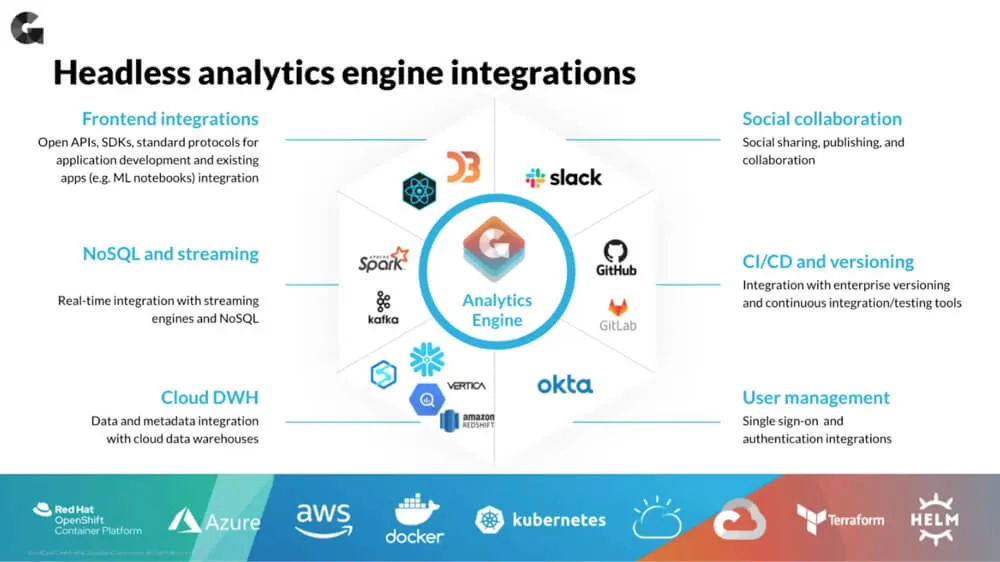10 Key questions and answers from our headless BI webinar


We recently held a webinar introducing you to headless BI, focusing on how it can be achieved through cloud-native API-first analytics. If you missed the webinar, or want to take another look, you can watch it here.
As with all our webinars, we allocated time for a Q&A session, helping to explore specific topics of interest in more depth. And with that in mind, we’ve created a list of the top headless-BI-related questions you asked and we answered.
Can you elaborate on how the headless BI engine supports DataOps teams?
The headless BI engine supports DataOps teams with its ability to be separated into development, Q&A, and production environments. It also gives the ability to capture anything, declaratively, in a versionable JSON or JAML file, which can be automated between the 3 environments and rolled out. The extensive API support and declarative abilities further underpin the platform’s DataOps-focused architecture.
Does the GoodData.CN front-end database support some form of versioning?
Yes. We support versioning on the code level, with all aspects of the widgets, settings, semantic model, and characteristics (chart type, colors, etc.) able to be defined in the code, dynamically. Alternatively, the widgets can reference the declarative configuration from the headless engine, allowing for easy user-customization.

Is it possible for two or more data analysts to collaborate on the front-end interface and build pieces of the dashboard simultaneously?
Yes. This is enabled by the declarative nature of the dashboard. The declarative definitions are human-readable and, as such, can be versioned and merged, thus supporting a parallel-development approach.
Why would we need to use the semantic model when we already have SQL?
The semantic model makes life easier for everyone. For those unfamiliar with SQL, the semantic model means that they don’t need to learn how to write SQL queries, and for those familiar with SQL, instead of having to write 30 to 40 new queries for each dashboard, with the semantic model, only three to five measures need to be written, which can also be re-used. See our blog post for more in-depth information.
Why not try our 30-day free trial?
Fully managed, API-first analytics platform. Get instant access — no installation or credit card required.
Get startedDoes the declarative API set cover the whole functionality of the engine?
Yes. Everything from the demo; all objects and all metadata, can be defined declaratively through APIs. Actions and tasks can be leveraged through APIs also, like for example, adding new a data source.
Which components are open-sourced?
Currently GoodData.UI is open-sourced, and there is potential to do the same with GoodData.CN Community Edition in the future. SDKs and drivers are open-sourced also.
Have you designed the solution to primarily work in a specific environment, like Azure for example?
No, not really. The cloud-native technology of GoodData.CN is fairly normalized and designed to run on public or private clouds or on-premises.
Can the self-service analytics tools be embedded into a UI app similar to the individual widgets?
Yes, absolutely. The Analytical Designer and Dashboard tool can both be embedded into an application or web portal, for example. This allows them to be customizable by end users regardless of technical ability.
Should I start with the Free Production Edition or Docker image Community Edition?
The hosted version (Free Production Edition) doesn’t require installation and is a little easier to get started with. The Docker image, however, is best suited to developers.
What is the pricing structure of GoodData.CN?
GoodData.CN is comprised of two versions; the Community Edition and the Production Edition. The former is deployed as an all-in-one Docker image and is free of charge, offering full functionality, and designed as a developer solution. When you’re ready to roll out a production environment, the Production Edition is available in three pricing tiers; Free, Growth, and Enterprise, and is designed to be run on public cloud, private cloud, or on-premises via Helm chart. For full details see our website.
Ready to learn more?
If you are interested in GoodData.CN, please contact us. Alternatively, sign up for a trial version of GoodData Cloud: https://www.gooddata.com/trial/
Why not try our 30-day free trial?
Fully managed, API-first analytics platform. Get instant access — no installation or credit card required.
Get started

